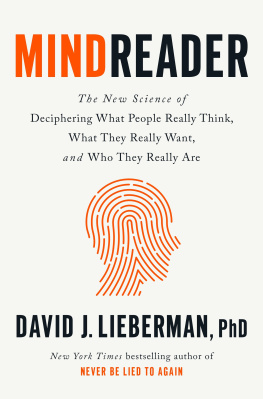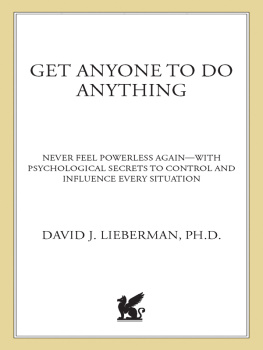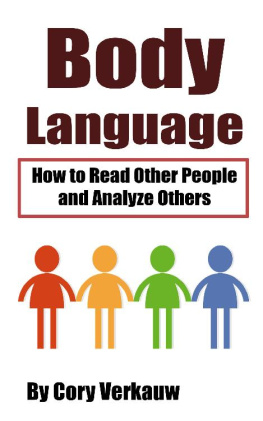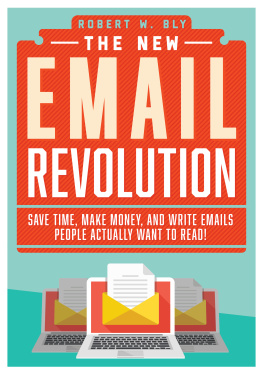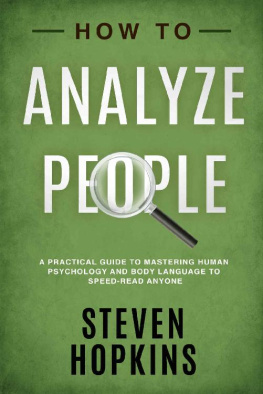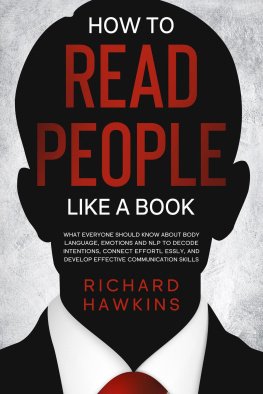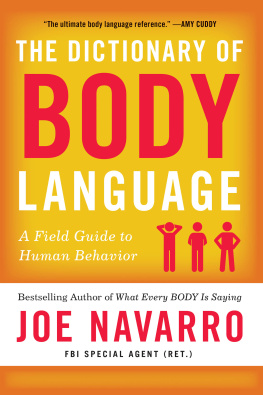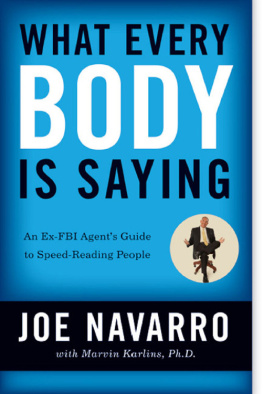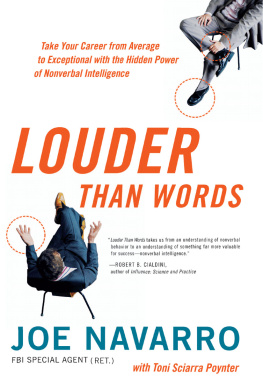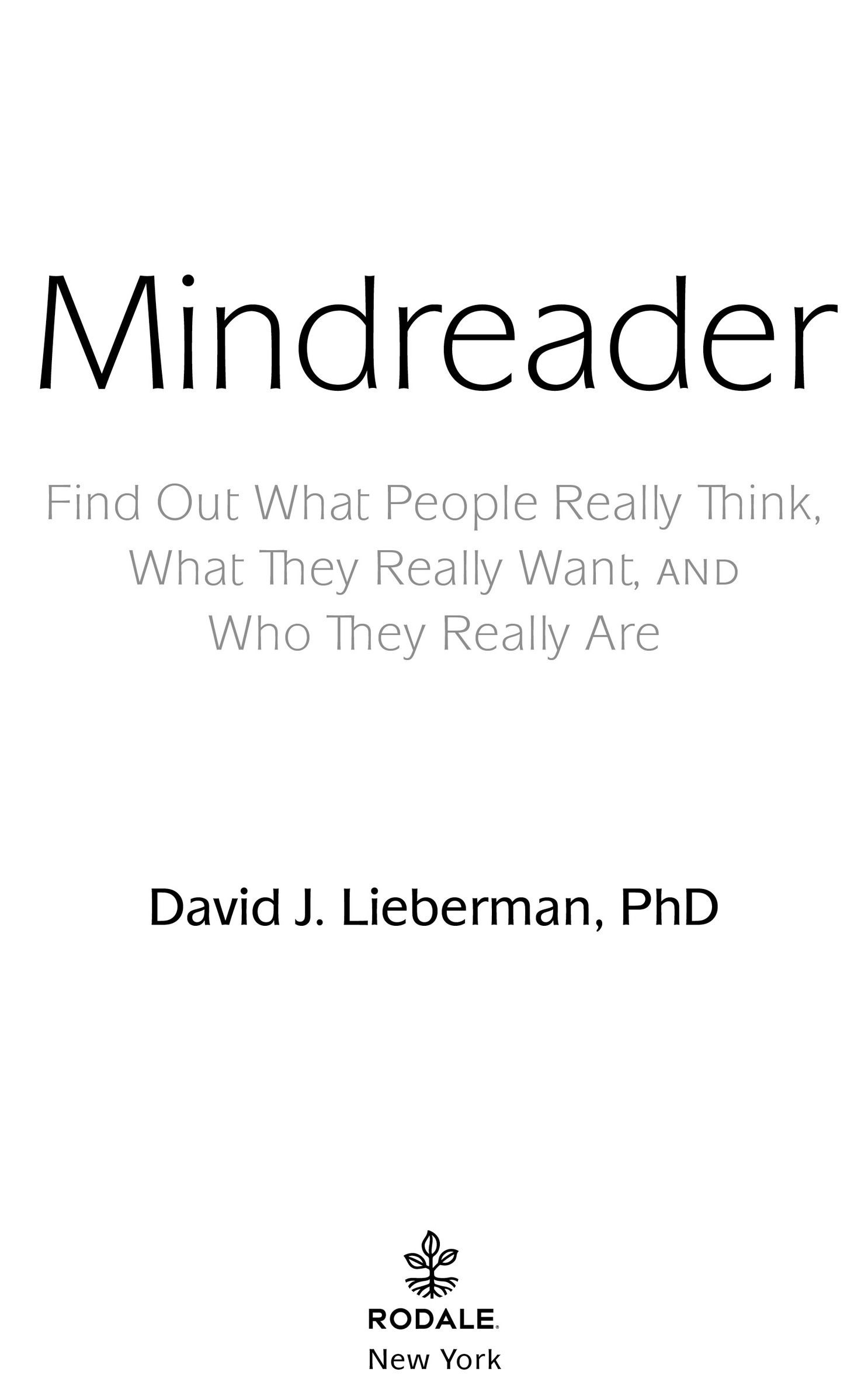Contents
Landmarks
Print Page List
Copyright 2022 by David J. Lieberman
All rights reserved.
Published in the United States by Rodale Books, an imprint of Random House, a division of Penguin Random House LLC, New York.
rodalebooks.com
RODALE and the Plant colophon are registered trademarks of Penguin Random House LLC.
Library of Congress Cataloging-in-Publication Data
Names: Lieberman, David J., author.
Title: Mindreader : find out what people really think, what they really want, and who they really are / David J. Lieberman, PhD.
Description: First edition. | New York : Rodale, [2022] | Includes bibliographical references.
Identifiers: LCCN 2021047599 (print) | LCCN 2021047600 (ebook) | ISBN 9780593236185 (hardcover) | ISBN 9780593236192 (ebook)
Subjects: LCSH: Psycholinguistics. | Body language. | Deception. | Interpersonal communicationPsychological aspects.
Classification: LCC BF455 .L488 2022 (print) | LCC BF455 (ebook) | DDC 401/.9dc23/eng/20211216
ISBN9780593236185
Ebook ISBN9780593236192
Print book design by Andrea Lau
Cover design by Pete Garceau
ep_prh_6.0_140632922_c0_r0
CONTENTS
Discover what someone really thinkseven thoughts that lie deep in their subconscious mindno matter what they say or do.
Find out how a person really feels about those in their lifewhom they feel close to, whom they admire, and whom they secretly despise.
Learn how to tell if any conversation, interaction, or new relationship is going your way or the other way. Is the other person just being polite, or are they genuinely interested and engaged?
Who is holding all the cards? Regardless of what anyone claims, youll know whether a person feels in control or insecure within any relationship.
Feelings of anger and anxiety leak out through seemingly kind and benign language and gestures. Decode the signs of hidden emotions to know what people are feeling, despite how they appear.
Whenever youre speaking with a suspect, coworker, or new acquaintance, find out if theyre going to be open and honest, or guarded and deceitful.
They make a threat, to walk out or to sue; they make a claim, to expose you or to protect you. Instantly know if they are just blowing smoke out of desperation or making a declaration of true intention.
Quickly determine whether someones account of any incident or experience is the absolute truth or nothing but a complete work of fiction.
See through the psychological tactics used by master manipulators and con artists to get rational people to behave in utterly irrational ways.
Find out whether anyone you meeta potential hire, blind date, or new babysitterhas an easygoing and agreeable nature or is a force of nature just waiting to be unleashed.
We all have a narrative that explains who I am and why I am. Because human beings dont easily go off-script, once you know their story, youll not only know what theyre thinking, but youll also be able to predict what theyll do next.
When we take notice of how people see themselves and their worldwhat attracts their attention and what they avoid; what they mention and what they miss; what they accept and what they rejectwe know their strengths, insecurities, and struggles.
The values that we hold announce to the world what matters to us most and paint a picture of our deepest selves. Pierce anyones public persona and youll know what makes them tick.
When a person is under pressure or dealing with stress, learn how to tell who will bend and who will breakand how to spot cracks before they even appear.
People who suffer from emotional illness share common language patterns, which broadcast their perceptions of reality. Learn all about a persons inner world in a single conversation.
Uncover the myth of the self-loving narcissist and find out how to tell who has self-esteem and who suffers from a deep-seated feeling of inferiority and self-hatred.
Discover why some people push your buttons and your boundariesand why you too often let them. More importantly, know how to spot any personality disorder type, including the well-hidden and polished sociopath.
Whether youre working with a patient, interviewing a potential hire, or making small talk with a colleague, detect the dead giveaways of mental illness in minutes.
Some people put on a brave front. Learn how to tell who really has it all together and who may be suffering silently on the inside.
People dont just snap. Identify the advance warning signs for those who are poised to become a danger to themselves or to others.
Introduction
For thirty years, Ive been developing psychological insights into human nature with strategies to enhance the quality of peoples lives and relationships. In 1998, I wrote a book, called Never Be Lied to Again, that introduced specifically formulated techniques to help people detect deception in their everyday lives. Nearly a decade later, I wrote You Can Read Anyone, which was a follow-up to the first book and updated the science of reading people. Now, roughly another decade later, thanks to emerging research in psycholinguistics, neuroscience, and the cognitive and behavioral sciences, this new book takes a quantum leap forward. I will introduce you to the most advanced, cutting-edge methods in profiling people, which will give you near-telepathic abilities. In any situationfrom a casual conversation to an in-depth negotiationyou will find what people really think and feel, regardless of what they claim. You will be privy to what lies deep in their subconscious mind, even when they themselves may be in denial and unwilling (or unable) to confront their thoughts, feelings, and fears on a conscious level.
Mindreader covers brand-new ground and relies little on age-old, outdated body language signs and signals. Many experts, for example, claim that crossed arms and legs suggest defensiveness or disagreement. While this interpretation is not technically wrong, you will get a lot of false positives if your subject is seated in a cold room in a chair without an armrest. And yes, little or no direct eye contact is a classic sign of deception. But the bad guys already know this, so unless your subject is a five-year-old caught with his hand in an actual cookie jar, youll need more sophisticated tactics. More chillingly, how do you accurately read a psychotic person who believes his own lies? Or a sociopath who looks you straight in the eyes and swears up and down on a stack of Bibles that hes telling the truth?
We can now also move well beyond stereotypical strategies for reading people that purport to reveal stunning insights into the psyche based on superficial observations of dress. Does a religious pendant reflect deeply held spiritual values? Not necessarily. Maybe the person is wearing one to offset guilt because she lives antithetically to such ideals. Maybe she wears it for sentimental reasons, perhaps because it was her grandmothers. Do a power suit and well-shined shoes indicate ambition, and are sweatpants a sign of laziness? Not at all. Perhaps someone dresses casually because shes comfortable in her own skin and doesnt care what others think; then again, maybe shes grossly insecure but wants to appear not to care.
Another stalwart favorite is to extrapolate assumptions based on a single behavior. But this is nonsense. Just because your friend is always late doesnt necessarily mean hes inconsiderate. Maybe hes a perfectionist who has to have everything just right before he leaves. Maybe he gets an adrenaline rush by waiting until the last minute. Maybe his mother always insisted that he be on time and is leading a subconscious rebellion. Maybe hes a bit spacey and loses track of time. If we rely on surface assumptions, the opportunities to misread people are endless.

